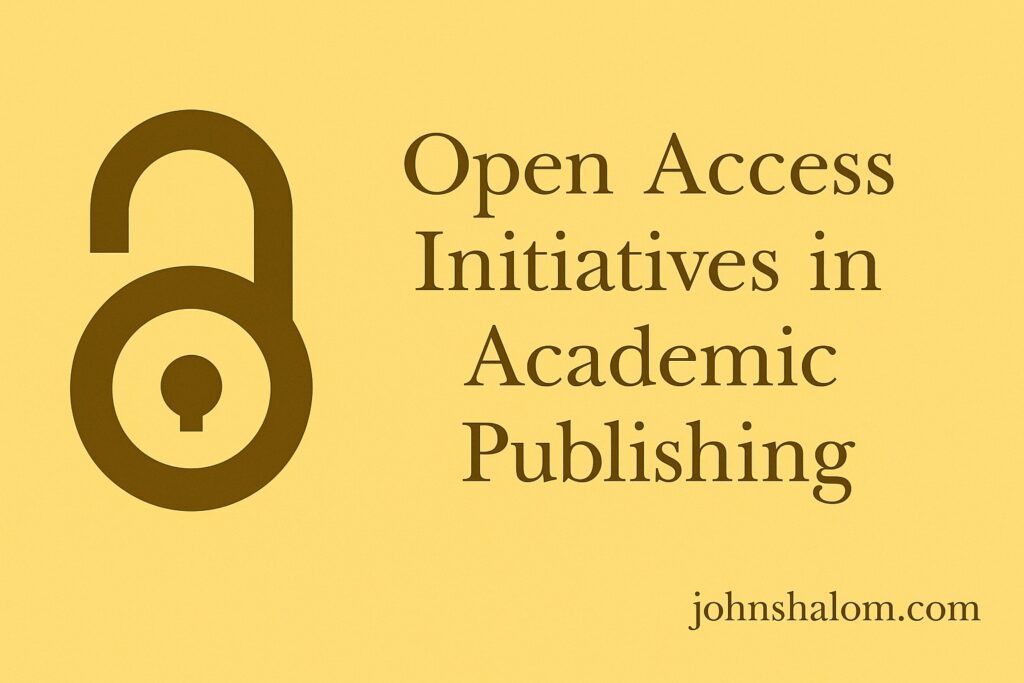
TL;DR:
Open access is changing how the world learns. By removing paywalls, it gives everyone—from students to researchers—equal access to knowledge. These initiatives aim to democratize information, foster collaboration, and accelerate innovation across disciplines.
The world of academic publishing is in a state of transformation, driven by the need for greater accessibility and transparency. Open access (OA) initiatives have emerged as a powerful force in breaking down barriers to scholarly communication, ensuring that knowledge is available to all.
This article explores the various open access initiatives in academic publishing, highlighting their significance, impact, and the challenges they face. Keywords for this article include: open access, academic publishing, scholarly communication, and access to knowledge.
FAQs: Open Access in Academic Publishing
1. What is open access in academic publishing?
Open access means scholarly research is freely available online for anyone to read, download, and share without subscription barriers.
2. Why is open access important?
It promotes equality in education and research, ensuring that knowledge is accessible regardless of geography or income.
3. What are the main types of open access models?
The two main types are Gold (immediate open access, often with author fees) and Green (self-archiving versions in repositories).
4. How does open access benefit researchers and institutions?
It increases visibility, citation rates, and global impact, helping authors reach broader audiences faster.
5. Are there challenges with open access publishing?
Yes, including publication costs, quality control, and the rise of predatory journals that exploit the model without proper peer review.
The Importance of Open Access
Open access refers to the free, immediate, and unrestricted online access to scholarly research. This model contrasts with traditional subscription-based publishing, which often limits access to those who can afford costly journal subscriptions. The significance of open access lies in its ability to democratize knowledge, fostering greater inclusivity and equity in academic research.
Key Benefits of Open Access
- Increased Visibility and Impact: Open access articles are more widely accessible, leading to higher visibility and citation rates. Researchers, practitioners, and the general public can access and benefit from these publications without subscription barriers.
- Democratization of Knowledge: Open access levels the playing field, allowing researchers from all backgrounds, including those in developing countries, to access cutting-edge research. This promotes global collaboration and advances the collective knowledge base.
- Faster Dissemination: Open access facilitates the rapid dissemination of research findings, accelerating the pace of scientific discovery and innovation.
You might also like The Ultimate Guide to Academic Writing: Structure, Style, and Success in Research
Major Open Access Initiatives
Several open access initiatives have gained prominence in recent years, each with its own approach and focus. These initiatives are driving the shift towards more accessible and transparent academic publishing.
1. Plan S
Plan S is a bold initiative launched by cOAlition S, a consortium of research funding organizations. It mandates that, starting from 2021, all research funded by cOAlition S members must be published in open access journals or platforms. Plan S aims to ensure that publicly funded research is freely accessible to everyone.
2. The Budapest Open Access Initiative
The Budapest Open Access Initiative (BOAI) was one of the first formal statements advocating for open access. Launched in 2002, it calls for the removal of access barriers to scholarly research and encourages the adoption of open access principles by institutions, publishers, and researchers.
3. The Public Library of Science (PLOS)
The Public Library of Science (PLOS) is a nonprofit open access publisher that offers a range of high-quality scientific journals. PLOS operates under the principle that scientific knowledge should be freely available to all, without restrictions. PLOS journals are widely recognized for their rigorous peer review and high impact.
4. Directory of Open Access Journals (DOAJ)
The Directory of Open Access Journals (DOAJ) is a comprehensive index of open access journals from around the world. It provides researchers with a reliable resource for finding reputable open access publications. DOAJ also sets standards for quality and transparency in open access publishing.
Open Access Models
Open access publishing can take various forms, each with its own advantages and considerations. Understanding these models is essential for researchers and institutions navigating the open access landscape.
1. Gold Open Access
Gold open access refers to articles that are freely available upon publication, with publishing costs typically covered by article processing charges (APCs) paid by authors or their institutions. This model ensures immediate access but may pose financial challenges for researchers without sufficient funding.
2. Green Open Access
Green open access involves self-archiving, where authors deposit a version of their manuscript in an institutional repository or a subject-specific archive. This model allows for wider dissemination without requiring APCs, but access may be delayed due to embargo periods imposed by publishers.
3. Diamond Open Access
Diamond open access journals provide free access to readers and do not charge APCs to authors. These journals are often supported by academic institutions, societies, or government funding. The diamond model promotes inclusivity by removing financial barriers for both readers and authors.
Challenges and Considerations
While open access initiatives offer numerous benefits, they also face several challenges and considerations:
1. Funding and Sustainability
Ensuring the financial sustainability of open access publishing is a significant challenge. Funding models vary, and there is ongoing debate about the most effective ways to support open access without compromising quality.
2. Quality and Peer Review
Maintaining rigorous peer review standards is crucial for the credibility of open access journals. There is a need to ensure that open access publications uphold the same quality standards as traditional subscription-based journals.
3. Copyright and Licensing
Open access often involves more permissive licensing, such as Creative Commons licenses, which allow for greater sharing and reuse of research. However, navigating copyright and licensing issues can be complex for authors and publishers.
The Future of Open Access
The future of academic publishing is undoubtedly intertwined with the continued growth and evolution of open access. Several trends are shaping the future of open access initiatives:
1. Increasing Institutional Support
Academic institutions and libraries are playing a vital role in promoting open access. Many institutions have established open access policies, created institutional repositories, and supported initiatives like Plan S.
2. Technological Advancements
Technological advancements, such as digital repositories, preprint servers, and open access platforms, are enhancing the discoverability and accessibility of research. These technologies facilitate the rapid dissemination of knowledge and foster collaboration.
3. Global Collaboration
Open access promotes global collaboration by breaking down barriers to knowledge. Researchers from around the world can access and contribute to the global knowledge pool, advancing scientific discovery and innovation.
Conclusion
Open access initiatives are revolutionizing academic publishing by breaking down barriers to scholarly communication and ensuring that knowledge is accessible to all. These initiatives promote inclusivity, accelerate scientific discovery, and enhance the impact of research. While challenges remain, the continued growth and evolution of open access promise a more equitable and transparent future for academic publishing. As the academic community embraces open access, we move closer to a world where knowledge is truly a public good, accessible to everyone, everywhere.


